Firefighting with a distance-based restriction
IF 1
3区 数学
Q3 MATHEMATICS, APPLIED
引用次数: 0
Abstract
In the classic version of the game of firefighter, on the first turn a fire breaks out on a vertex in a graph and then firefighters protect vertices. On each subsequent turn, the fire spreads to the collective unburnt neighbourhood of all the burning vertices and the firefighters again protect vertices. Once a vertex has been burnt or protected it remains that way for the rest of the game. A common objective with respect to some infinite graph is to determine how many firefighters are necessary to stop the fire from spreading after a finite number of turns, commonly referred to as containing the fire. We introduce the concept of distance-restricted firefighting where the firefighters’ movement is restricted so they can only move up to some fixed distance per turn rather than being able to move without restriction. We establish some general properties of this new game in contrast to properties of the original game, and we investigate specific cases of the distance-restricted game on the infinite square, strong, and hexagonal grids. We conjecture that two firefighters are insufficient on the infinite square grid when , and we pose some questions about how many firefighters are required in general when .
有距离限制的消防
在经典版本的消防员游戏中,在第一个回合中,图G中的一个顶点发生火灾,然后k名消防员保护k个顶点。在随后的每个回合中,火势会蔓延到所有燃烧点的未燃烧区域,消防员再次保护k个点。一旦一个顶点被烧毁或保护,它就会在游戏的剩余时间里保持这种状态。对于某个无限图G,一个常见的目标是确定需要多少消防员才能在有限的回合数(通常称为控制火势)后阻止火势蔓延。我们引入了距离限制消防的概念,即消防员的移动受到限制,因此他们每回合只能移动固定的距离d,而不是不受限制地移动。我们建立了这种新博弈的一些一般性质,并与原博弈的性质进行了对比,并研究了无限方格、强方格和六边形方格上的距离限制博弈的具体情况。我们推测当d=2时,两个消防员在无限方形网格上是不够的,我们提出了一些问题,即当d=1时,一般需要多少消防员。
本文章由计算机程序翻译,如有差异,请以英文原文为准。
求助全文
约1分钟内获得全文
求助全文
来源期刊

Discrete Applied Mathematics
数学-应用数学
CiteScore
2.30
自引率
9.10%
发文量
422
审稿时长
4.5 months
期刊介绍:
The aim of Discrete Applied Mathematics is to bring together research papers in different areas of algorithmic and applicable discrete mathematics as well as applications of combinatorial mathematics to informatics and various areas of science and technology. Contributions presented to the journal can be research papers, short notes, surveys, and possibly research problems. The "Communications" section will be devoted to the fastest possible publication of recent research results that are checked and recommended for publication by a member of the Editorial Board. The journal will also publish a limited number of book announcements as well as proceedings of conferences. These proceedings will be fully refereed and adhere to the normal standards of the journal.
Potential authors are advised to view the journal and the open calls-for-papers of special issues before submitting their manuscripts. Only high-quality, original work that is within the scope of the journal or the targeted special issue will be considered.
 求助内容:
求助内容: 应助结果提醒方式:
应助结果提醒方式:


